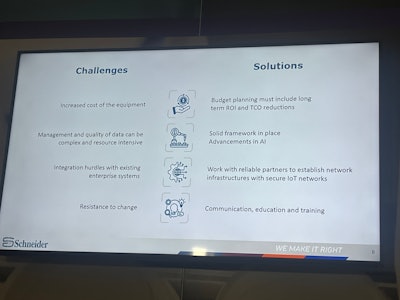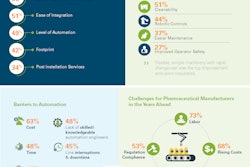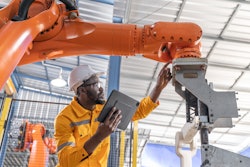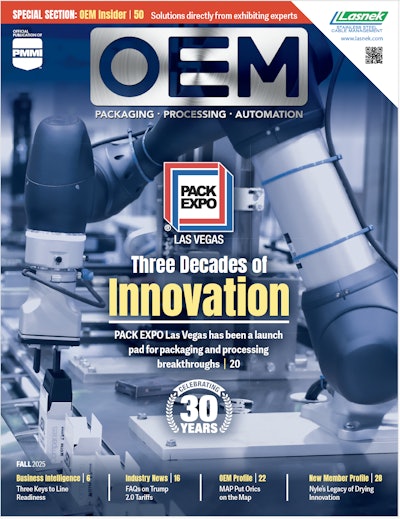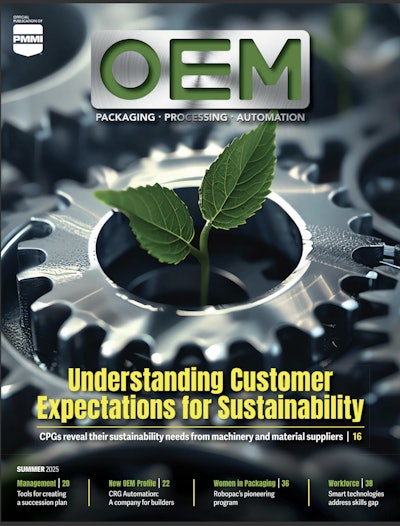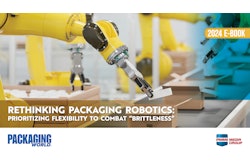Predictive maintenance is gaining traction in packaging and processing. Jamie Barber, Director of Product Development at Schneider Packaging, recently used the PACK EXPO International Innovation Stage to discuss how Schneider applies predictive maintenance in case packers and robotic palletizers. This approach leverages data collection and analysis to predict equipment failures, allowing for timely maintenance and minimizing unplanned downtime.
Case packers and robotic palletizers involve complex systems, including vacuum and pneumatic systems, servo and variable-frequency drives (VFDs), and robotic arms. Predictive maintenance can identify potential failure points within these systems by monitoring airflow, pressure, torque, and temperature. This proactive approach prevents catastrophic failures and optimizes maintenance schedules, extending equipment lifespan and enhancing overall productivity.
For example, Barber explained that in a case packer, some common points of failure could be within the vacuum source itself, the valves controlling the vacuum zones, the vacuum cups, or the air circuits and points of connection. Collecting airflow and pressure data through monitoring of the vacuum system can help identify and predict when maintenance is needed before system failure. Further monitoring networks can be deployed to each faction zone to pinpoint specific areas with flow and pressure monitoring of the end-of-arm tool vacuum system, and a baseline profile can be established for comparison to actual measurements taken over time. Trends indicating consistent deviation from baseline can preemptively inform personnel of pending failures. As Barber highlighted with one Schneider customer, an ancillary benefit of a monitoring system like this is also valuable when more acute problems occur.
“We had a customer once who replaced a worn robot cable dress out and routed it improperly,” Barber said. “The result was a vacuum leak while transporting the product during a particular robot motion. This was causing the vacuum supply to be lost temporarily and the product dropped.”
The facility struggled with this intermittent issue for days. Eventually, occasionally dropping products turned into frequently dropping products, and the facility support team escalated the issue to Schneider for assistance. It took several people numerous hours to pinpoint the issue over multiple days before resolution.
“With a data-driven solution in place, the vacuum loss could have been pinpointed during each robot cycle, providing the technical team with a more informed understanding of the problem and drastically decreasing their mean time to repair,” he said.
Barber highlighted Schneider’s use of advanced tools like Fanuc's Zero Downtime (ZDT) application. Fanuc, Schneider's exclusive strategic partner and supplier of robotic systems, developed a zero downtime application to predictably monitor the health of their robot systems. ZDT is a global cloud-based IoT application with predictive analytics designed to monitor the health and performance of robots. Fanuc began collecting data in 2009 and currently has over 35,000 robots globally. ZDT provides many benefits, such as identifying critical items that must be addressed during non-production windows and performing maintenance proactively during scheduled downtime rather than reactively during operation time. This optimizes resources by performing maintenance based on the condition of the robot equipment instead of calendar intervals. This cloud-based IoT application employs predictive analytics to monitor robotic systems' health, reducing downtime and enhancing overall performance. It also helps with maintenance during non-production windows, optimizing resources and reducing operational disruptions.
However, predictive maintenance has some challenges, such as increased equipment and infrastructure costs, data management complexities, and integration hurdles. Addressing these requires careful budget planning, resource evaluation, and collaboration with skilled partners. Additionally, overcoming employees' resistance to change necessitates effective communication and training.
“Resistance from employees to adopt new technologies is often a struggle. Include your stakeholders early in the process,” Barber said. “Keep them informed as you progress and solicit their feedback frequently.”
Barber advised starting small, focusing on specific systems like vacuum or pneumatic components, and gradually scaling up.
“If the thought of infrastructure overhaul for data collection is daunting, a good start could be the implementation of sensor hardware to collect baseline equipment performance,” he said. “This could be broken down further to just the vacuum systems or pneumatics or drives. You don't need to adapt them all at once.”
Essential steps in this process include identifying pain points and defining expected outcomes.
“Investigate your processes and equipment. Where are you seeing the largest or most frequent pain points?” he said. “I've highlighted critical pain points in case packing and palletizing for monitoring, but this expands further to the rest of your production line as well. Define expected outcomes from those pain points.”
Prioritizing actions and maintaining open communication with stakeholders can facilitate successful implementation.
Predictive maintenance offers significant benefits, including reduced downtime, cost savings, and improved equipment reliability. Predicting and addressing issues before they escalate enhances product quality, safety, and customer satisfaction.
